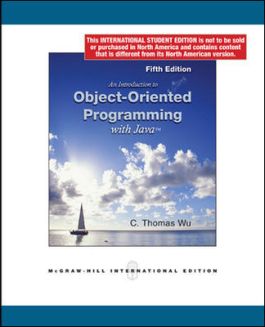An Introduction to Object-Oriented Programming with Java (Int'l Ed)
Receive via shipping:
- Colour, print bound version of the complete text
Chapter 0 Introduction to Computers and Programming LanguagesChapter 1 Introduction to Object-Oriented Programming and Software DevelopmentChapter 2 Getting Started with JavaChapter 3 Numerical DataChapter 4 Defining Your Own Classes - Part 1Chapter 5 Selection StatementsChapter 6 Repetition StatementsChapter 7 Defining Your Own Classes - Part 2Chapter 8 Exceptions and AssertionsChapter 9 Characters and StringsChapter 10 ArraysChapter 11 Sorting and SearchingChapter 12 File Input and OutputChapter 13 Inheritance and PolymorphismChapter 14 GUI and Event-Driven ProgrammingChapter 15 Recursive AlgorithmsAppendix A How to Run Java ProgramsAppendix B List of Sample ProgramsAppendix C Standard Classes and InterfacesAppendix D UML Diagrams
Chapter 2 Getting Started with JavaChapter 3 Numerical DataChapter 4 Defining Your Own Classes - Part 1Chapter 5 Selection StatementsChapter 6 Repetition StatementsChapter 7 Defining Your Own Classes - Part 2Chapter 8 Exceptions and AssertionsChapter 9 Characters and StringsChapter 10 ArraysChapter 11 Sorting and SearchingChapter 12 File Input and OutputChapter 13 Inheritance and PolymorphismChapter 14 GUI and Event-Driven ProgrammingChapter 15 Recursive AlgorithmsAppendix A How to Run Java ProgramsAppendix B List of Sample ProgramsAppendix C Standard Classes and InterfacesAppendix D UML Diagrams
Chapter 4 Defining Your Own Classes - Part 1Chapter 5 Selection StatementsChapter 6 Repetition StatementsChapter 7 Defining Your Own Classes - Part 2Chapter 8 Exceptions and AssertionsChapter 9 Characters and StringsChapter 10 ArraysChapter 11 Sorting and SearchingChapter 12 File Input and OutputChapter 13 Inheritance and PolymorphismChapter 14 GUI and Event-Driven ProgrammingChapter 15 Recursive AlgorithmsAppendix A How to Run Java ProgramsAppendix B List of Sample ProgramsAppendix C Standard Classes and InterfacesAppendix D UML Diagrams
Chapter 6 Repetition StatementsChapter 7 Defining Your Own Classes - Part 2Chapter 8 Exceptions and AssertionsChapter 9 Characters and StringsChapter 10 ArraysChapter 11 Sorting and SearchingChapter 12 File Input and OutputChapter 13 Inheritance and PolymorphismChapter 14 GUI and Event-Driven ProgrammingChapter 15 Recursive AlgorithmsAppendix A How to Run Java ProgramsAppendix B List of Sample ProgramsAppendix C Standard Classes and InterfacesAppendix D UML Diagrams
Chapter 8 Exceptions and AssertionsChapter 9 Characters and StringsChapter 10 ArraysChapter 11 Sorting and SearchingChapter 12 File Input and OutputChapter 13 Inheritance and PolymorphismChapter 14 GUI and Event-Driven ProgrammingChapter 15 Recursive AlgorithmsAppendix A How to Run Java ProgramsAppendix B List of Sample ProgramsAppendix C Standard Classes and InterfacesAppendix D UML Diagrams
Chapter 10 ArraysChapter 11 Sorting and SearchingChapter 12 File Input and OutputChapter 13 Inheritance and PolymorphismChapter 14 GUI and Event-Driven ProgrammingChapter 15 Recursive AlgorithmsAppendix A How to Run Java ProgramsAppendix B List of Sample ProgramsAppendix C Standard Classes and InterfacesAppendix D UML Diagrams
Chapter 12 File Input and OutputChapter 13 Inheritance and PolymorphismChapter 14 GUI and Event-Driven ProgrammingChapter 15 Recursive AlgorithmsAppendix A How to Run Java ProgramsAppendix B List of Sample ProgramsAppendix C Standard Classes and InterfacesAppendix D UML Diagrams
Chapter 14 GUI and Event-Driven ProgrammingChapter 15 Recursive AlgorithmsAppendix A How to Run Java ProgramsAppendix B List of Sample ProgramsAppendix C Standard Classes and InterfacesAppendix D UML Diagrams
Appendix A How to Run Java ProgramsAppendix B List of Sample ProgramsAppendix C Standard Classes and InterfacesAppendix D UML Diagrams
Appendix C Standard Classes and InterfacesAppendix D UML Diagrams
Wu uses a gentler approach to teaching students how to design their own classes, separating the coverage into two chapters. GUI coverage is also located independently in the back of the book and can be covered if desired.
Wu also features a robust set of instructors' materials including PowerPoint slides, code samples, and quiz questions.
McGraw Hill Connect is an award-winning digital teaching and learning solution that empowers students to achieve better outcomes and enables instructors to improve course management efficiency.
High-Quality Course Material
Our trusted solutions are designed to help students actively engage in course content and develop critical higher-level thinking skills while offering you the flexibility to tailor your course to the ways you teach and the ways your students learn.
Assignments & Automatic Grading
Connect features a question bank that you can select from to create homework, practice tests and quizzes. Dramatically reduce the amount of time you spend reviewing homework and grading quizzes, freeing up your valuable time to spend on teaching.
Analytics & Reporting
Monitor progress and improve focus with Connect’s visual and actionable dashboards. Reports are available to empower both instructors and students with real-time performance analytics.
Seamless Integration
Link your Learning Management with Connect for single sign-on and gradebook synchronization, with all-in-one ease for you and your students.


